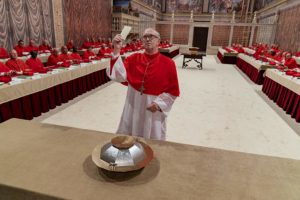
Two Stellar Performances = The Two Popes
When Pope Francis became the pope in 2013 it was historical on a number of levels. Pope Francis was the first pope who came from the Western Hemisphere (Argentina) and the first pope since the 8th century to be born outside of Europe. What might be even more historic about his election, however is that it came after his predecessor, Pope Benedict XVI, voluntarily resigned, which hadn’t occurred in more than 700 years. Since almost every pope holds the position until death, the Catholic Church was in an unusual position where it had two living popes who had very different philosophies about the Church. The drama, The Two Popes explores the personal relationship between Pope Benedict/Cardinal Ratzinger and Pope Francis/Cardinal Bergoglio, who are expertly played by Anthony Hopkins (Thor: Ragnarok, 2017) and Jonathan Pryce (The Wife, 2017). Directed by accomplished Brazilian director Fernando Meirelles, the movie succeeds in making a story centered on religious philosophies and the role of the Church into a highly enjoyable film about two different paths to leadership.
The film begins with the death of Pope John Paul II in 2005 and interweaves actual news reports of his death and funeral along with scenes of Cardinal Jorge Bergoglio and Cardinal Joseph Ratzinger. Cardinal Bergoglio (who will later become Pope Francis) is introduced to audiences preaching to a crowded congregation in the streets of Buenos Aires about his childhood.
Bergoglio is a man of the people with a message of reform social justice. In contrast, Cardinal Ratzinger is introduced as an elder statesman in the Vatican who embraces the conservative Catholic Church. Audiences follow Cardinal Ratzinger as he is walking through the Vatican ahead of a meeting for the College of Cardinals while reviewing a list of the cardinals to ensure he remembers all names and backgrounds.

The College of Cardinals has come together to elect a new pope and the audience is given a fascinating look at the behind-the-scenes process in which the cardinals pick their new pope (a papal conclave) as they are sequestered in the beautiful Sistine Chapel. After a failed first ballot, in which Ratzinger receives the most votes and Bergoglio pulls in the second most votes, the next ballot is a success. Cardinal Ratzinger will be the new pope and assumes the name Benedict. The new pope is introduced to the people in St. Peter’s Square while Cardinal Bergoglio returns to Argentina discouraged about the direction the Church is going.
After a montage of real news clips, audiences realize the challenges Benedict faces in his papacy, including sexual abuse claims, financial misdealing at the Vatican Bank and concerns that the church is too conservative for modern Catholics. This montage essentially marks the end of the first act of the film. The remainder of the story and the heart of the film involves several one-on-one meetings, over the years, between the conservative Pope Benedict and the reform-minded (future) Pope Francis along with flashbacks to Francis’s early years. These flashbacks included scenes that were shot on location in Buenos Aires. In fact, they even filmed in the exact spot where Pope Francis made the decision to enter the priesthood.

Despite what might appear to be dry subject matter, The Two Popes is a surprisingly engaging and enlightening drama. A large reason for this movie working is the performances of the leads Anthony Hopkins and Jonathan Pryce. Both actors fully embody the characters and, by the end of the film, one might think the actual popes are starring in the film (although this is aided by how much they resemble both in real life). Pryce is likely to receive award attention for his performance as he is fantastic in this role.
From a storytelling perspective, Fernando Meirelles, the director, succeeds at consistently weaving in historical footage and flashbacks, which help make the film much more engaging by breaking up the dialogue-heavy scenes. Meirelles also utilizes the beauty of the filming locations including Buenos Aires and Rome, to infuse more energy than a play version of this story ever could. The scenes at the Vatican and the Pope’s summer palace (Casa Gandolfo) illuminate the grandeur of the Catholic Church compared to the scenes in Francis’s Argentina, which show a different kind of Catholic Church that is more oriented towards the people.
In addition to the performances and direction, the film, which is centered around a dialogue-heavy script may receive an adapted screenplay nomination. The script, adapted from Anthony McCarten’s “The Pope,” is outstanding and gives audiences a strong sense of these two exceptional men. The moments that delve into Francis’s earlier life as a Jesuit priest under a military dictatorship in Argentina were especially enlightening. Francis is really the protagonist in this story, however it doesn’t villainize Benedict either. Benedict explains how his arch-conservative approach to faith, while well-intentioned, started to falter in the new millennium.

As the two overcome their initial distrust of each other, its heartwarming to see them unearth commonalities, a mutual respect for each other and their values in a way that unfortunately feels foreign in the current political climate.
Bottom Line: The Two Popes is an enjoyable and enlightening drama about two very different men who became the head of the Catholic Church with incredible performances by Anthony Hopkins and Jonathan Pryce.
Credits: Written by Anthony McCarten and directed by Fernando Meirelles
Starring: Jonathan Pryce (Cardinal Jorge Bergoglio/ Pope Francis), Anthony Hopkins (Pope Benedict), Juan Minujín (Young Jorge Bergoglio), Sidney Cole (Cardinal Peter Turkson), Lisandro Fiks (Father Jalics)
Studio: Netflix
Running Time: 125 minutes
Jessica DeLong © November 26, 2019
**Check out Sarah Knight Adamson’s interview with screenplay writer Anthony McCarten.
